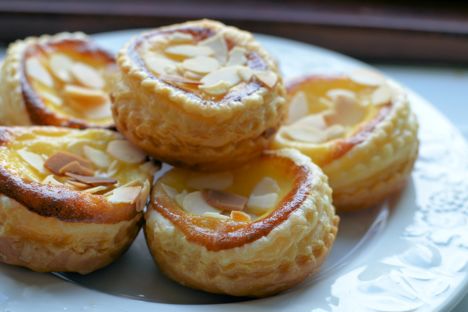
Dan tat to melktert: custard tarts around the world
Flaky pastry and silky, rich custard – what’s not to love? From the classic British dessert and iconic Portuguese pastel de nata to ones less familiar, we look at how different countries put their spin on humble custard tarts and pies.
Dan tat to melktert: custard tarts around the world
Flaky pastry and silky, rich custard – what’s not to love? From the classic British dessert and iconic Portuguese pastel de nata to ones less familiar, we look at how different countries put their spin on humble custard tarts and pies.
A meeting point of buttery pastry and smooth, creamy filling, the beauty of a custard tart lies in its simplicity. But what might appear uncomplicated masks plenty of technical skill – a good custard tart requires excellently baked pastry – a tricky balancing act in itself – and perfectly set custard, another testing task. When done right, they’re hard to top and it’s no wonder they’ve become such a staple dessert here in the UK.
We are, though, far from the only country which celebrates the pockets of indulgence. Portuguese pastel de natas (which have been made since as early as the thirteenth century) are not only cherished in their home country, but loved around the world, while other versions are popular everywhere from Hong Kong and Romania to South Africa. Here, we’ve taken a look at just a handful of the ways custard tarts are enjoyed around the world, and, of course, included some recipes for the classic pastry if you’re keen to give them a whirl yourself.
United Kingdom
So loved are custard tarts in the UK that a version by Marcus Wareing was chosen as the final course of the Great British Menu banquet to celebrate Queen Elizabeth II’s eightieth birthday in 2006 (you can find his classic custard tart recipe here). They date back as far as 1399, when they were served at a coronation banquet for Henry IV. Today, they are found in bakeries and supermarkets up and down the country, both as small single tarts and bigger wheels, made with an egg custard and shortcrust pastry and topped with a sprinkle of nutmeg. Though it’s hard to top the classic, they’re also a base on which chefs put their own spin; Nathan Outlaw makes an espresso version with sugared pistachios, Lorna McNee loves a pumpkin custard tart and Sarah Frankland uses a miso caramel in hers.
Hong Kong
Hong Kong-style custard tarts are thought to have first originated in China (they’re known as dan tat in Cantonese). Its roots are in the British version, with a creamy filling and crumbly shortcrust pastry, having been introduced to the southern Chinese city of Guangzhou in the 1920s by the British. After the Second World War, emigration saw the tart find its way to Hong Kong, with which it has since become more commonly linked. Today, both shortcrust and puff versions can be found at bakeries and on the menus of dim sum restaurants.
Portugal
A regular pitstop for tourists, the popularity of pastel de natas means they have travelled far outside Portugal’s borders, popping up on menus across Western Europe (it’s not difficult to track one down in bakeries here in the UK), Asia and former Portuguese colonies including Brazil and Macau. They are believed to have been created by monks at the Jerónimos Monastery near Lisbon around the eighteenth century – at that time, convents and monasteries used egg whites for starching clothes, with the leftover yolks used in cakes and pastries. Portugal’s take on the custard tart includes a puff pastry crust, with a vanilla and cinnamon-spiked custard. The top is often blistered to give it the trademark colour and crunch, before being dusted with powdered sugar or cinnamon.
South Africa
Melktert is a popular South African dessert originally created by Dutch settlers in the seventeenth century. It’s made of a sweet pastry crust and a custard filling, though the ratio of milk to eggs is higher than in Chinese and Portuguese versions, giving it a lighter texture and stronger milk flavour. It’s thought to have evolved from the Dutch mattentaart, a cheesecake-like dessert. Cinnamon is often sprinkled over the top, and a cinnamon stick usually flavours the milk before custard is made, while many recipes also include nutmeg and cardamom.
Brazil
Sticky and vibrant, Brazil’s quindão (or quindim) is a baked coconut custard flan with a distinctive bright yellow, glazed top, thanks to the generous use of egg yolks. One of the country’s most cherished desserts – the tarts are often eaten on special occasions and at gatherings – it usually has a slightly chewy coconut base and is topped with a set custard. The use of egg yolks nods to Brazil’s history with Portugal, which also has a soft spot for yolk-heavy baking, while the influence of coconut and sugar can be traced back to its African history.
Greece
The Greek take on a custard tart is galaktoboureko, a semolina custard dessert where the filling, infused with vanilla and lemon, is baked between sheets of filo pastry and doused with hot sugar syrup (which is sometimes spiked with orange blossom). It might be less familiar outside Greece, but there it’s as well-known – and loved – as baklava.
Romania
We might be stretching the definition of custard tarts here, but in Romania the sweet treats are transformed into thin pancakes filled with a rich vanilla custard, called clătite (the Romanian take on crepes) cu crema de vanilie. Pile them high and plate them up during festive occasions and celebrations.


